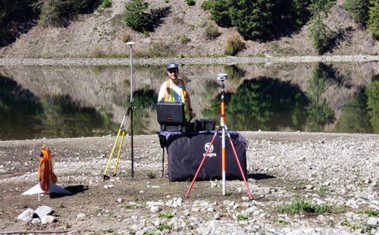It’s been three years since the Economic Trust of the Southern Interior (ETSI-BC) and Mitacs launched their research funding partnership serving the Southern Interior of BC, and they are excited to share some key outcomes and reflect on future opportunities.
The partnership was launched in 2021 out of a shared interest by ETSI-BC and Mitacs to encourage collaborative research projects that would help address economic challenges and opportunities faced by the region’s local communities, First Nations, industry and non-profits, in partnership with the region’s public post-secondary institutions.
“Strong ties between industry and post-secondary institutions are an important component of successful economic development strategies,” says Laurel Douglas, CEO of ETSI-BC. “By supporting internships through our funding partnership with Mitacs, ETSI-BC can help solve industry challenges, support emerging industry clusters to grow and innovate, and help create economic opportunities in rural and Indigenous communities.
Funded by the federal government, all provinces, and one territory, Mitacs works with over 190 universities, colleges, institutes, and polytechnics, thousands of companies, not-for-profit organizations, municipalities, and hospitals to build partnerships that support innovation in Canada.
“We are very proud of the collaboration with ETSI-BC, which has enabled multiple impactful projects in BC’s Southern Interior,” says Dr. John Hepburn, CEO of Mitacs.
Dr. Mike Kennefick, the Senior Advisor, Business Development and National Lead of Rural Development at Mitacs, agrees. “The funding from ETSI-BC was a great incentive to encourage smaller post-secondary institutions in BC’s Southern Interior, especially colleges, to take advantage of Mitacs funding.”
Public Post-Secondary Institutions in the BC Southern Interior
| College of the Rockies – Cranbrook | Nicola Valley Institute of Technology – Merritt |
| Selkirk College – Castlegar | Thompson Rivers University – Kamloops |
| Okanagan College – Kelowna | UBC Okanagan – Kelowna |
How It Works
Colin Gervais, also a Senior Advisor, Business Development at Mitacs explains, “People work with Mitacs for three reasons: to conduct research that addresses specific innovation challenges, to access a talent pipeline that is hard to come by, and/or a combination of both. Partnering with ETSI-BC provides extra funding for projects that fit with the objectives of both organizations.”
Mitacs provides a minimum $10,000 stipend while an intern — a college, undergraduate, or graduate student, or a postdoctoral fellow — participates in a four- to six-month project with a post-secondary institution. The institution may also choose a $15,000 funding model where up to $5,000 can be used for eligible project costs, or to top up an intern’s stipend. A portion of the project cost is supported by a grant from ETSI-BC, which is paid directly to the post-secondary institution by Mitacs on behalf of ETSI-BC.
A project may include diverse resources, from students to professors from all academic disciplines. This includes someone in an academic supervisory role with expertise in a specific field, and a student working in the same space.
Positive Outcomes Achieved
The funding partnership has resulted in outcomes that stretch beyond the direct funding benefit. Partners in selected projects illustrate some of the ways:
Dr. Sarah-Patricia Breen from Selkirk College on Innovation Support

Dr. Sarah-Patricia Breen, Selkirk College’s BC Regional Innovation Chair in Rural Economic Development, was an intern for Mitacs in 2015 while completing her PhD in Resource and Environmental Management. In her current role, she has overseen numerous projects supported by the ETSI-BC/Mitacs partnership.
“A major advantage is how the program reduces barriers for partner organizations such as colleges to participate in research,” says Breen. “In rural areas, college faculty may not have the capacity to prepare applications and supervise research projects. Mitacs has been very flexible in adapting its partnership with ETSI-BC to ensure its resources are accessible to colleges in remote communities and First Nations.”
The grant money provided by ETSI-BC can be enough to support a college during the application process. “One of the things we’ve done at Selkirk is create cluster projects which bring together several partners in a series of internships related to a common theme such as rural resilience,” says Breen. “This reduces the college’s workload with less time spent reviewing multiple applications and hiring students.”
“At the end of the day,” says Breen, “students are the ones who benefit most from this partnership as they develop new expertise and take advantage of networking opportunities that help them secure jobs,” says Breen.
Mike Overend of TOTA on Assisting Industry Associations
“Since the partnership between ETSI-BC and Mitacs began, the number of projects and their complexity has really picked up steam,” says Gervais. “It has catalysed post-secondary institutions to collaborate more with each other, and with industry groups and municipal organizations in the Southern Interior.
“These groups are becoming more involved in research and innovation to shape their goals and how they achieve them. The momentum continues to build as awareness of successful projects supported by this partnership grows,” continues Gervais.
A research project involving the Thompson Okanagan Tourism Association (TOTA) is an example of the growing importance of research to industry. TOTA worked with UBC Okanagan to research the impact of changing weather patterns on ski resorts in the Southern Interior.
“Data from the tourism sector is sometimes difficult to source,” says Mike Overend, Director of Destination Development and Stewardship at TOTA. “We have visitation numbers and other statistics, but the collaboration with the post-secondary institution has expanded the scope of what we can learn and share within the tourism sector. The credibility of a well-established organization such as TOTA and a top-ranking university like UBC Okanagan supported the researchers in gaining complex data they needed. “Communication and collaboration within the ski resort sector has also increased through this project,” says Overend.
A final report was provided to ski resorts across the region to help them better plan for future weather impacts. Such research is made available through the TOTA’s Tourism Impact Portal, a central data portal for information on tourism development in BC.
“We are still working on what research we should be involved with,” says Overend. “It’s a new frontier out there for industry research groups.”
Vadim Stolyarov of Above Sensing on Assisting Private Industry and Start-ups
When Vadim Stolyarov moved to the Kootenays in 2019, his search for meaningful work, fascination with drones, and desire to start his own company led him enroll in Selkirk College’s Geographic Information System (GIS) program from 2020 until 2022.

While committed to his full-time studies and research, Vadim also founded Above Sensing with a business partner, Santiago Botero. “Once the company was started, we needed to prove ourselves until our name became recognized,” Vadim says.
Vadim’s final thesis involved research into tree species identification using data collected by drones. Drones can provide access to areas that are hard to reach, making them highly efficient tools to help manage natural resources.
Through Selkirk College, Vadim learned about research funding opportunities with Mitacs and applied to Mitacs’s Accelerate Entrepreneur program. As a student doing work that would benefit his company, he performed the role of research intern. Much of the work took place in the Skattebo forest near Castlegar on land used by Selkirk College for research and other educational purposes.
ETSI-BC paid the first installment of the project funding. Mitacs provided a $10,000 stipend for one semester and $5,000 for equipment which was used to purchase a powerful computer system needed for the research. The partners also received mentoring and coaching to support the new start-up.
“The first two years with the business were really hard, but that early support from ETSI-BC gave us the capacity to focus on the research with a wage coming in,” says Vadim. “Having a team of people who are truly invested in your success is incredibly invigorating.”
Above Sensing strives to be at the forefront of green resource technology. It has gone on to do work for the BC Ministry of Forests, First Nations, and Wildsite Creston Valley, a leader in large-scale conservation stewardship. A salesperson joined the team in 2024. “With the support of ETSI-BC and Mitacs, we’re realizing our dreams,” Vadim says.
Claire McLoughlin on Supporting Social Enterprises
In 2020, Claire McLoughlin and Katie Forsyth launched Friendly Composting, a social enterprise in Kamloops that addresses climate change through effective waste management, and the creation of sustainable local food systems. Social enterprises are businesses with a social or environmental mission at their core.
As Friendly Compost started to grow, the company worked with social enterprise accelerator Purppl to refine its business model and receive coaching in such areas as leadership, organizational structure and strategic decision making.

When Claire went on to do her Master of Science in Environmental Economics and Management at Thompson Rivers University (TRU), her final thesis saw her working with Purppl from a research perspective
Claire was intrigued by the lack of knowledge about the specific challenges and drivers of social enterprises when they try to scale. The funding partnership between ETSI-BC and Mitacs provided support while she completed her thesis on the Challenges of Scaling Social Enterprises in Canada.
Information from staff and clients of PURPPL provided the basis for the research and Claire conducted more than 40 interviews with founders and leaders, beneficiaries, and contributors to social enterprises. Claire’s instructor, Dr. Bruce Martin, Professor of Human Enterprise and Innovation and head of TRU’s Innovation for Social Good research cluster, worked with Claire throughout the research period. “Claire did an excellent job creating a master’s thesis with a large positive impact on both the theory and practical aspects of social enterprise development,” says Hamilton.

“I was able to influence businesses in a positive way, including my own, and the results are contributing to academic content as a new area of research,” adds Claire. “With the funding from ETSI-BC and Mitacs, I could really delve into the work without financial pressures.”
The final thesis will be made available online by TRU later this year.
Excited for the Next Funding Partnership
After supporting 35 projects in their first funding partnership, ETSI-BC and Mitacs are delighted to share that they have signed a new 3-year agreement that will provide funding for even more projects over ETSI-BC’s new strategic plan cycle, from 2024-2027. “It’s been a pleasure to work with Mike and Colin of Mitacs since 2021. We look forward to seeing the innovation and ingenuity that this next round will bring forward,” notes Laurel Douglas, CEO of ETSI-BC.
“This partnership with the Economic Trust of Southern Interior will help us provide support for innovation in this prolific region of British Columbia, tapping into ETSI-BC’s extensive connections and expertise. We are committed to driving economic growth and productivity and to bringing innovation for more people in more places across Canada and the world,” said Dr. John Hepburn, CEO of Mitacs.


